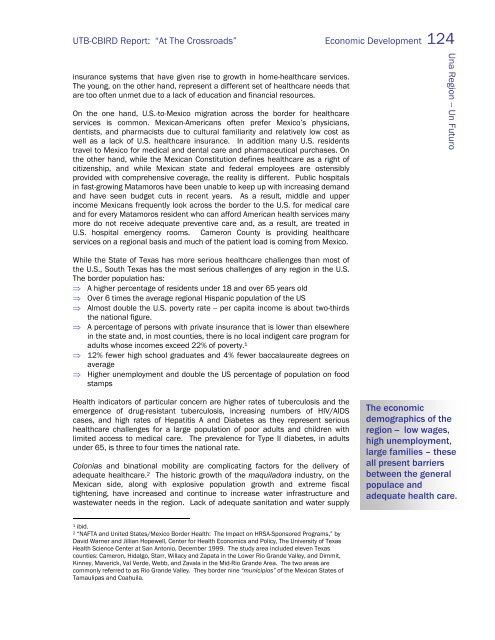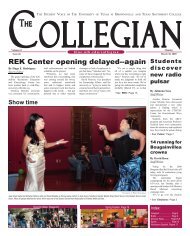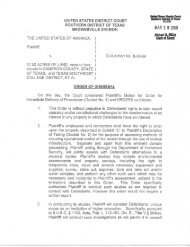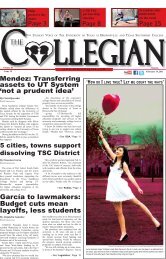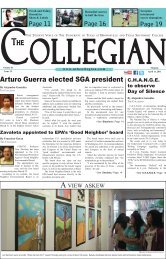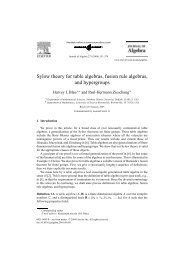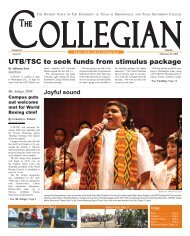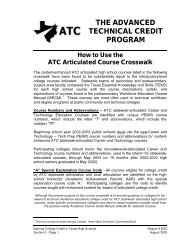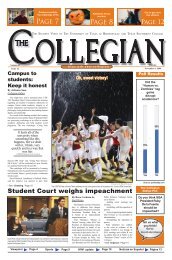cameron county/matamoros - blue - The University of Texas at ...
cameron county/matamoros - blue - The University of Texas at ...
cameron county/matamoros - blue - The University of Texas at ...
You also want an ePaper? Increase the reach of your titles
YUMPU automatically turns print PDFs into web optimized ePapers that Google loves.
UTB-CBIRD Report: “At <strong>The</strong> Crossroads” Economic Development 124<br />
insurance systems th<strong>at</strong> have given rise to growth in home-healthcare services.<br />
<strong>The</strong> young, on the other hand, represent a different set <strong>of</strong> healthcare needs th<strong>at</strong><br />
are too <strong>of</strong>ten unmet due to a lack <strong>of</strong> educ<strong>at</strong>ion and financial resources.<br />
On the one hand, U.S.-to-Mexico migr<strong>at</strong>ion across the border for healthcare<br />
services is common. Mexican-Americans <strong>of</strong>ten prefer Mexico’s physicians,<br />
dentists, and pharmacists due to cultural familiarity and rel<strong>at</strong>ively low cost as<br />
well as a lack <strong>of</strong> U.S. healthcare insurance. In addition many U.S. residents<br />
travel to Mexico for medical and dental care and pharmaceutical purchases. On<br />
the other hand, while the Mexican Constitution defines healthcare as a right <strong>of</strong><br />
citizenship, and while Mexican st<strong>at</strong>e and federal employees are ostensibly<br />
provided with comprehensive coverage, the reality is different. Public hospitals<br />
in fast-growing M<strong>at</strong>amoros have been unable to keep up with increasing demand<br />
and have seen budget cuts in recent years. As a result, middle and upper<br />
income Mexicans frequently look across the border to the U.S. for medical care<br />
and for every M<strong>at</strong>amoros resident who can afford American health services many<br />
more do not receive adequ<strong>at</strong>e preventive care and, as a result, are tre<strong>at</strong>ed in<br />
U.S. hospital emergency rooms. Cameron County is providing healthcare<br />
services on a regional basis and much <strong>of</strong> the p<strong>at</strong>ient load is coming from Mexico.<br />
While the St<strong>at</strong>e <strong>of</strong> <strong>Texas</strong> has more serious healthcare challenges than most <strong>of</strong><br />
the U.S., South <strong>Texas</strong> has the most serious challenges <strong>of</strong> any region in the U.S.<br />
<strong>The</strong> border popul<strong>at</strong>ion has:<br />
⇒ A higher percentage <strong>of</strong> residents under 18 and over 65 years old<br />
⇒ Over 6 times the average regional Hispanic popul<strong>at</strong>ion <strong>of</strong> the US<br />
⇒ Almost double the U.S. poverty r<strong>at</strong>e -- per capita income is about two-thirds<br />
the n<strong>at</strong>ional figure.<br />
⇒ A percentage <strong>of</strong> persons with priv<strong>at</strong>e insurance th<strong>at</strong> is lower than elsewhere<br />
in the st<strong>at</strong>e and, in most counties, there is no local indigent care program for<br />
adults whose incomes exceed 22% <strong>of</strong> poverty. 1<br />
⇒ 12% fewer high school gradu<strong>at</strong>es and 4% fewer baccalaure<strong>at</strong>e degrees on<br />
average<br />
⇒ Higher unemployment and double the US percentage <strong>of</strong> popul<strong>at</strong>ion on food<br />
stamps<br />
Health indic<strong>at</strong>ors <strong>of</strong> particular concern are higher r<strong>at</strong>es <strong>of</strong> tuberculosis and the<br />
emergence <strong>of</strong> drug-resistant tuberculosis, increasing numbers <strong>of</strong> HIV/AIDS<br />
cases, and high r<strong>at</strong>es <strong>of</strong> Hep<strong>at</strong>itis A and Diabetes as they represent serious<br />
healthcare challenges for a large popul<strong>at</strong>ion <strong>of</strong> poor adults and children with<br />
limited access to medical care. <strong>The</strong> prevalence for Type II diabetes, in adults<br />
under 65, is three to four times the n<strong>at</strong>ional r<strong>at</strong>e.<br />
Colonias and bin<strong>at</strong>ional mobility are complic<strong>at</strong>ing factors for the delivery <strong>of</strong><br />
adequ<strong>at</strong>e healthcare. 2 <strong>The</strong> historic growth <strong>of</strong> the maquiladora industry, on the<br />
Mexican side, along with explosive popul<strong>at</strong>ion growth and extreme fiscal<br />
tightening, have increased and continue to increase w<strong>at</strong>er infrastructure and<br />
wastew<strong>at</strong>er needs in the region. Lack <strong>of</strong> adequ<strong>at</strong>e sanit<strong>at</strong>ion and w<strong>at</strong>er supply<br />
1 ibid.<br />
2 “NAFTA and United St<strong>at</strong>es/Mexico Border Health: <strong>The</strong> Impact on HRSA-Sponsored Programs,” by<br />
David Warner and Jillian Hopewell, Center for Health Economics and Policy, <strong>The</strong> <strong>University</strong> <strong>of</strong> <strong>Texas</strong><br />
Health Science Center <strong>at</strong> San Antonio, December 1999. <strong>The</strong> study area included eleven <strong>Texas</strong><br />
counties: Cameron, Hidalgo, Starr, Willacy and Zap<strong>at</strong>a in the Lower Rio Grande Valley, and Dimmit,<br />
Kinney, Maverick, Val Verde, Webb, and Zavala in the Mid-Rio Grande Area. <strong>The</strong> two areas are<br />
commonly referred to as Rio Grande Valley. <strong>The</strong>y border nine “municipios” <strong>of</strong> the Mexican St<strong>at</strong>es <strong>of</strong><br />
Tamaulipas and Coahuila.<br />
Una Region -- Un Futuro<br />
<strong>The</strong> economic<br />
demographics <strong>of</strong> the<br />
region -- low wages,<br />
high unemployment,<br />
large families – these<br />
all present barriers<br />
between the general<br />
populace and<br />
adequ<strong>at</strong>e health care.


